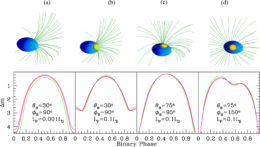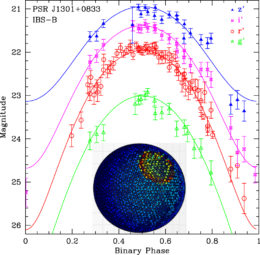Hanging out in a binary system with a hot millisecond pulsar can be hazardous to your health! A new study has examined how these perilous objects can heat and evaporate away their companions.
Predatory Stars

Panel (a) shows the intrabinary shock and the companion star (the pulsar would lie to the right). Panel (b) shows the companion star and the magnetic field lines funneling into its front pole. [Adapted from Sanchez & Romani 2017]
Such systems, termed “black widows” in an acknowledgement of how the pulsar effectively consumes its partner, show optical emission revealing their strong heating. We hope that by studying these systems, we can learn more about the properties of the energetic winds emitted by pulsars, and by measuring the companion dynamics we can determine the masses of the pulsars and companions in these systems.

Different geometries for the companion’s magnetic field lines can alter the resulting light curve for the system. [Sanchez & Romani 2017]
How Heating Happens
Past models of black widows — necessary to interpret the observations — have generally assumed that the companion’s evaporation was due only to direct heating by the energetic gamma-ray photons emitted by the pulsar. This scenario, however, doesn’t successfully reproduce some of the quirks we’ve observed for these systems, such as very large temperatures and asymmetric light curves.
This picture also ignores the fact that much of the pulsar’s spin-down energy — the energy lost as it gradually spins slower and slower — is carried away by not just the gamma-ray photons, but also a magnetized wind of electrons and positrons. Two scientists at Stanford University, Nicolas Sanchez and Roger Romani, asked the following: how could the particles in the pulsar wind contribute to the heating of a black widow’s companion?
A Shock Assists
Sanchez and Romani’s alternative model relies on the fact that somewhere between the pulsar and its companion lies an intrabinary shock — the collision point between the pulsar’s relativistic wind and the companion’s ordinary, baryonic wind. The shock is anchored to the companion via magnetic fields, which provides an entry point for shock particles to be funneled along the magnetic field lines onto the companion’s surface. These energetic particles, in addition to the direct irradiation by the pulsar’s photons, cause the heating of the companion that results in its evaporation.Sanchez and Romani show via simulations that this model can reproduce the observed light curves of several known black widow systems — including the strange features that the direct-heating model didn’t account for. They then use their model to make estimates for the masses of the pulsars and companions in these systems.
The authors caution that this model is still incomplete, but it illustrates that other sources of heating are important to consider in addition to heating by photons. Applying this and similar models to more black-widow systems will surely help us to better understand how these predatory compact stars cause their companions’ ultimate demise.
Citation
Nicolas Sanchez and Roger W. Romani 2017 ApJ 845 42. doi:10.3847/1538-4357/aa7a02


9 Comments
Pingback: black widow consumes companion
Pingback: Tech: 10 of the coolest things in space that you had no idea existed – Evanews24
Pingback: Tech: 10 of the coolest things in space that you had no idea existed – Vanesglobalgist
Pingback: Tech: 10 of the coolest things in space that you had no idea existed - NAIJADAD
Pingback: 10 of the coolest things in space that you had no idea existed | Business Insider
Pingback: كوكبٌ يمطر الزجاج.. وآخر يحتوي على ثلج يحترق! أروع 10 أشياء في الفضاء لم تتخيل وجودها – راصد
Pingback: Dalla nube spaziale che profuma di rum al pianeta dove piove vetro, 10 cose affascinanti nello spazio che non sapevi esistessero – Business Insider Italia
Pingback: كوكبٌ يمطر الزجاج.. وآخر يحتوي على ثلج يحترق! أروع 10 أشياء جميلة في الفضاء الخارجي لم تتخيل وجودها
Pingback: 10 cosas geniales del espacio que no sabías que existían | ADFBusiness